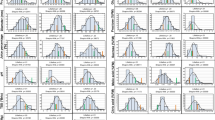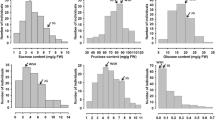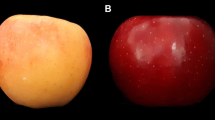Abstract
Efficient breeding and selection of high-quality apple cultivars requires knowledge and understanding of the underlying genetics. The availability of genetic linkage maps constructed with molecular markers enables the detection and analysis of major genes and quantitative trait loci contributing to the quality traits of a genotype. A segregating population of the cross between the apple varieties `Fiesta' (syn. `Red Pippin') and `Discovery' has been observed over three years at three different sites in Switzerland and data on growth habit, blooming behaviour, juvenile period and fruit quality has been recorded. QTL analyses were performed, based on a genetic linkage map consisting of 804 molecular markers and covering all 17 apple chromosomes. With the maximum likelihood based interval mapping method, the investigated complex traits could be dissected into a number of QTLs affecting the observed characters. Genomic regions participating in the genetic control of stem diameter, plant height increment, leaf size, blooming time, blooming intensity, juvenile phase length, time of fruit maturity, number of fruit, fruit size and weight, fruit flesh firmness, sugar content and fruit acidity were identified and compared with previously mapped QTLs in apple. Although `Discovery' fruit displayed a higher acid content, both acidity QTLs were attributed to the sweeter parent `Fiesta'. This indicated homozygosity at the acidity loci in `Discovery' preventing their detection in the progeny due to the lack of segregation.
Similar content being viewed by others
References
Aeppli, A., Gremminger, U., Kellerhals, M., Rapillard, C., Röthlisberger, K. and Rusterholz, P. 1989. Obstsorten, 3rd ed. Landwirtschaftliche Lehrmittelzentrale, Zollikofen, Switzerland, pp. 88-89.
Aldwinckle, H.S. 1975. Flowering of apple seedlings 16-20 months after germination. Hort. Sci. 10(2): 124-126.
Brown, A.G. and Harvey, D.M. 1971. The nature and inheritance of sweetness and acidity in the cultivated apple. Euphytica 20: 68-80.
Conner, J.P., Brown, S.K. and Weeden, N.F. 1998. Molecularmarker analysis of quantitative traits for growth and development in juvenile apple trees. Theor Appl Genet 96: 1027-1035.
Fischer, C. 1994. Shortening the juvenile period in apple breeding. In: H. Schmidt and M. Kellerhals (Eds.) Progress in Temperate Fruit Breeding, Kluwer Academic Publishers, Dordrecht, Netherlands, pp. 161-164.
Fischer, M. 1994. The Pillnitz apple rootstock breeding programme results. In: H. Schmidt and M. Kellerhals (Eds.) Progress in Temperate Fruit Breeding, Kluwer Academic Publishers, Dordrecht, Netherlands, pp. 161-164.
Haley, C.S., Knott, S.A. and Elsen, J.M. 1994. Mapping quantitative trait loci in crosses between outbred lines using least squares. Genetics 136: 1195-1207.
Hulme, A.C. and Rhodes, M.J.C. 1971 Pome fruits. In: A.C. Hulme (Ed.) The Biochemistry of Fruits and their Products, Academic Press, London, pp. 333-373.
Kellerhals, M., Dolega, E., Dilworth, E., Koller, B. and Gessler, C. 2000. Advances in marker-assisted apple breeding. Acta Hort. 583: 535-540.
Kellerhals, M. and Meyer, M. 1994. Aims of the apple breeding program at Wädenswil. In: H. Schmidt and M. Kellerhals (Eds.) Progress in Temperate Fruit Breeding, Kluwer Academic Publishers, Dordrecht, Netherlands, pp. 117-121.
King, G., Lynn, J., Dover, C.J. and Evans, K.M. 2001. Resolution of quantitative trait loci for mechanical measures accounting for genetic variation in fruit texture of apple (Malus pumila Mill.). Theor. Appl. Genet. 102: 1227-1235.
King, G.J., Maliepaard, C., Lynn, J.R., Alston, F.H., Durel, C.E., Evans, K.M., Griffon, B., Laurens, F., Manganaris, A.G., Schrevens, E., Tartarini, S. and Verhaegh, J. 2000. Quantitative genetic analysis and comparison of physical and sensory descriptors relating to fruit flesh firmness in apple (Malus pumila Mill.). Theor. Appl. Genet. 100: 1074-1084.
Knott, S.A. and Haley, C.S. 1992. Maximum likelihood mapping of quantitative trait loci using full-sib families. Genetics 132: 1211-1222.
Koller, B., Gianfranceschi, L., Seglias, N., McDermott, J. and Gessler, C. 1994. DNA markers linked to the Malus floribunda 821 scab resistance. Plant Mol. Biol. 26: 597-602.
Lander, E.S. and Botstein, D. 1989. Mapping mendelian factors underlying quantitative traits using RFLP linkage maps. Genetics 121: 185-199.
Lawson, D.M., Hemmat, M. and Weeden, N.F. 1995. The use of molecular markers to analyze the inheritance of morphological and developmental traits in apple. J. Am. Soc. Hort. Sci. 120: 532-537.
Liebhard, R., Koller, B., Gianfranceschi, L., and Gessler, C. in press. Creating a saturated reference map for the apple (Malus × domestica Borkh.) genome. Theor. Appl. Genet.
Maarse, H. (Ed.) 1991.Volatile Compounds in Food and Beverages. Marcel Dekker, New York, p. 30.
Maliepaard, C., Alston, F.H., Van Arkel, G., Brown, L.M., Chevreau, E., Dunemann, F., Evans, K.M., Gardiner, S., Guilford, P., van Heusden, A.W., Janse, J., Laurens, F., Lynn, J.R., Manganaris, A.G., Den Nijs, A.P.M., Periam, N., Rikkerink, E., Roche, P., Ryder, C., Sansavini, S., Schmidt, H., Tartarini, S., Verhaegh, J.J., Vrielink-Van Ginkel, M. and King, G.J. 1998. Aligning male and female linkage maps of apple (Malus pumila Mill.) using multi-allelic markers. Theor. Appl. Genet. 97: 60-73.
Mehlenbacher, S.A. and Voordeckers, A.M. 1991. Relationship of flowering time, rate of seed germination, and time of leaf bud break and usefulness in selecting for late-flowering apples. J. Am. Soc. Hort. Sci. 116: 565-568.
Murawski, H. 1967. Beiträge zur Züchtungsforschung beim Apfel. X. Ergebnisse bei der Züchtung von Apfelsorten mit spätem Laubaustrieb und Blühbeginn. Züchter 37: 134-139.
Nybom, N. 1959. On the inheritance of acidity in cultivated apples. Heriditas 45: 332-350.
Seglias, N. 1997. Genetische Kartierung quantitativer Merkmale beim Apfel. PhD Dissertation 12204, ETH Zürich, Switzerland.
Seglias, N.P. and Gessler, C. 1997. Genetics of apple powdery mildew resistance from Malus zumi (Pl2). IOBC/WPRS Bull. 20 (9): 195-208.
Silbereisen, R., Götz, G. and Hartmann, W. 1996. Obstsorten-Atlas. Eugen Ulmer.
Spotte, R.A., Stang, E.J. and Ferree, D.C. 1976. Effect of overtree misting for bloom delay on incidence of fire blight in apple. Plant Dis. Rep. 60: 329-330.
Tartarini, S., Gianfranceschi, L., Sansavini, S. and Gessler, C. 1999. Development of reliable PCR markers for the selection of the Vf gene conferring scab resistance in apple. Plant Breed. 118: 183-186.
Tydeman, H.T. 1958. The breeding of late flowering apple varieties. Rep. E. Malling Res. Stn. 1957: 68-73.
van Ooijen, J.W. 1999. LOD significance thresholds for QTL analysis in experimental populations of diploid species. Heredity 83: 613-624.
van Ooijen, J.W. and Maliepaard, C. 1996. MapQTL version 3.0: software for the calculation of QTL positions on genetic maps. CPRO-DLO, Wageningen, Netherlands.
Verhaegh, J.J., Visser, T. and Kellerhals, M. 1988. juvenile period of apple seedlings as affected by rootstock, bud origin and growth factors. Acta Hort. 224: 133-139.
Visser, T. 1970. The relation between growth, juvenile period and fruiting of apple seedlings and its use to improve breeding efficiency. Euphytica 19: 293-302.
Visser, T. and Verhaegh, J.J. 1978a. Inheritance and selection of some fruit characters of apple. I. Inheritance of low and high acidity. Euphytica 27: 753-760.
Visser, T. and Verhaegh, J.J. 1978b. Inheritance and selection of some fruit characters of apple.II. The relation between leaf and fruit pH as a basis for preselection. Euphytica 27: 761-765.
Visser, T., Schaap, A.A. and de Vries, D.P. 1968. Acidity and sweetness in apple and pear. Euphytica 17: 153-167.
Watkins, R. and Spangelo, L.P.S. 1970. Components of genetic variance for plant survival and vigor in apple trees. Theor. Appl. Genet. 40: 195-203.
Xu, M.L. and Korban, S.S. 2000. Saturation mapping of the apple scab resistance gene Vf using AFLP markers. Theor. Appl. Genet. 101: 844-851.
Young, H., Gilbert, J.M., Murray, S.H. and Ball, R.D. 1995. Causal effects of aroma compounds on Royal Gala apple flavours. J. Sci. Food Agric. 71: 329-336.
Zimmermann, R.H. 1971. Flowering in crabapple seedlings: methods of shortening the juvenile phase. J. Am. Soc. Hort. Sci. 96: 404-411.
Zimmermann, R.H. 1972. Length of juvenile period in some apomictic crab apples. Hort. Sci. 7: 490-491.
Author information
Authors and Affiliations
Corresponding author
Rights and permissions
About this article
Cite this article
Liebhard, R., Kellerhals, M., Pfammatter, W. et al. Mapping quantitative physiological traits in apple (Malus × domestica Borkh.). Plant Mol Biol 52, 511–526 (2003). https://doi.org/10.1023/A:1024886500979
Issue Date:
DOI: https://doi.org/10.1023/A:1024886500979




